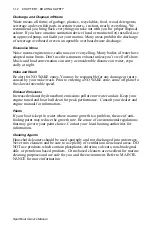
1-4 CHAPTER 1: BOATING SAFETY
Sport Boat Owner’s Manual
Keep the following PFD points in mind:
•
Set an example and wear your PFD. Require your passengers to wear them
also.
•
Make sure the PFD fits properly; this is especially important for children and
non-swimmers.
•
At the beginning of each season, check PFDs for damage and test for proper
flotation.
Fire Extinguisher
At least one approved B-1 portable fire extinguisher is
required on most boats. Make sure all passengers know
the location and operating procedure for each fire extin-
guisher.
Visual Distress Signals
Federal law also requires boats 4.8 m (16 ft.) and longer to
carry day and night visual distress signals when operating
on coastal waters, the Great Lakes, territorial seas or those
waters directly connected to them, up to a point where the
body of water is less than two miles wide.
NOTICE
Some signaling devices (pyrotechnics) are restricted from use on cer-
tain bodies of water, so always check with local authorities.
Recommended Equipment
As a precaution, a good boater will avoid potential
problems on an outing by having additional equip-
ment on board. Normally, this equipment is depen-
dent on the body of water and the length of the trip,
your dealer can assist you:
•
First aid kit and manual
•
Anchor with at least 23 m (75 ft.) of line
•
Mooring lines and fenders
•
Bailing device (bucket, hand pump, etc.)
•
Combination oar/boat hook
•
Day/night visual distress signal
•
Lubricant
•
Tool kit
•
Spare propeller, nut and washer
•
Spare fuses
•
Local charts and compass
•
Waterproof flashlight
•
Portable AM/FM radio with weather band
•
Spare flashlight and radio batteries
•
Sunglasses and sun block
OVERCHARGED
RECHARGE
KC-0083
KC-0090








































